Explosions, crushed buildings and flood fears. Mammoth Lakes thrown into chaos by snowfall
Worry and fear are running high in this snowbound Sierra Nevada ski town.
Buildings groan and crack under the strain of accumulated snowpack, forcing occupants to flee. Slabs of snow and ice plummet from rooftops with the force of falling pianos. Columns of smoke rise from homes whose gas lines have become fouled by snow, causing them to explode.
“We’re afraid of all the ways we could die here on any given day,” lamented Stacy Bardfield, a broker at Mammoth Sierra Properties and local resident of 47 years. “Will it be a roof caving in? A propane line blast? Fallen electric transmission lines?”
For a community whose economic livelihood has long relied on skiable powder, a winter of record snowfall has suddenly transformed the white stuff into an oppressive, occupying force.
As state officials warn Californians of treacherous snowmelt in the coming months, Mammoth Lakes still finds itself overwhelmed by snow that measures up to 30 feet deep. Shovel crews have been working around the clock to dig out businesses and homeowners, while demanding small fortunes for their sweat.
At the same time, residents have blasted town officials for what they see as a woeful lack of preparation for this year’s snowmageddon. For their part, officials have pleaded for the assistance of the California National Guard.
“Unfortunately, our town officials were months late in preparing for the task before us,” Bardfield said. “Now, it’s going to take an army to turn things around.”
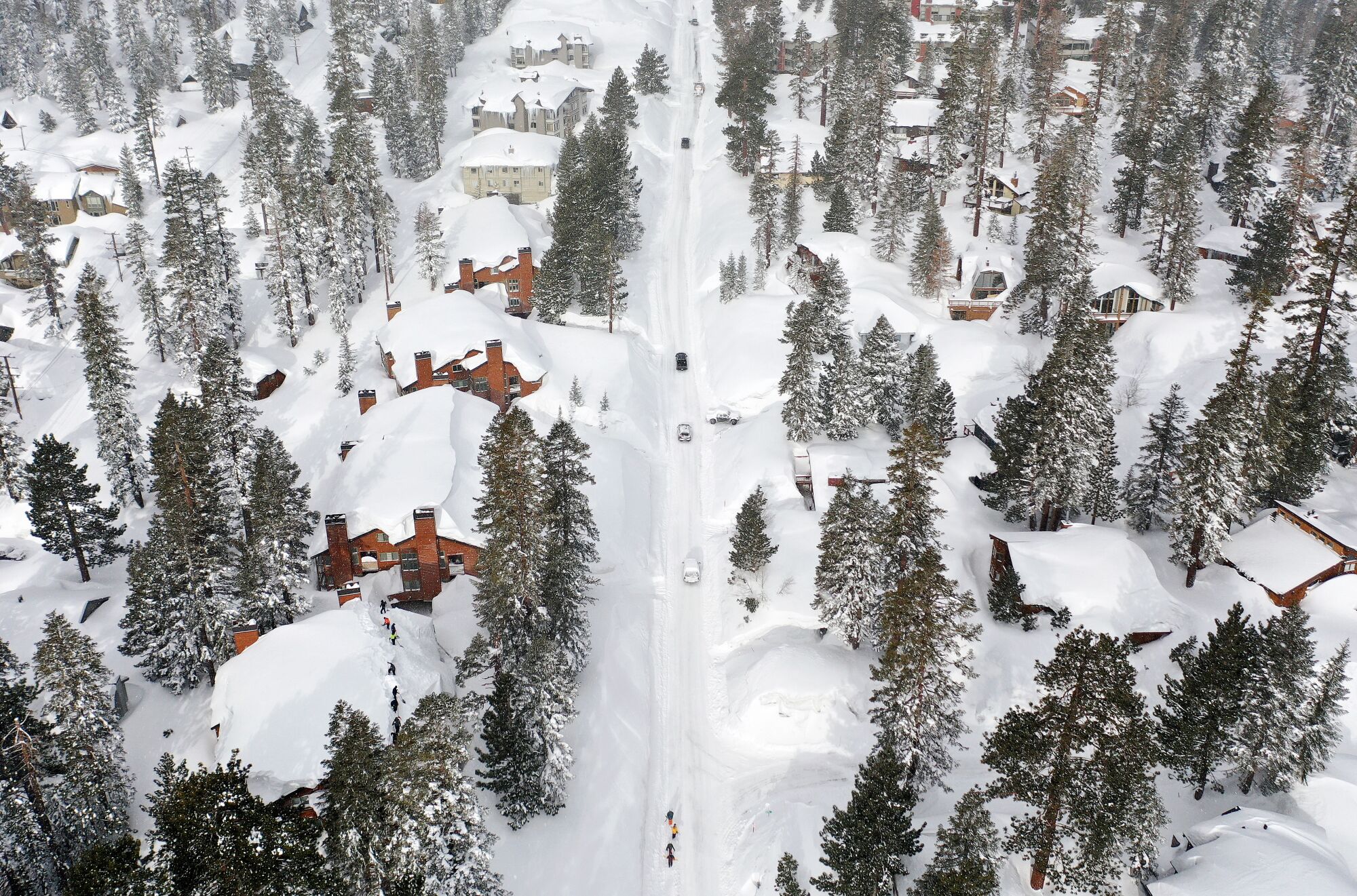
An aerial view of a residential street in Mammoth Lakes.
(Mario Tama/Getty Images)
Propane gas spewing from lines buried deep beneath the snow has already touched off two explosions. One leveled a building and injured five people two weeks ago. The other obliterated an unoccupied multimillion-dollar vacation home early on April 1, igniting a fire and triggering a flash flood of snowmelt that slammed into a nearby condominium complex.
By sunrise, Mammoth Mountain ski resort crews had cleaned up enough debris from the explosion to continue operating a nearby lift. “It was surreal to watch skiers climbing aboard the ski lift while smoke was still billowing into the sky a stone’s throw away,” one witness told The Times.
Mammoth Lakes Town Manager Daniel Holler has warned residents that “more such explosions are imminent.”
A state of emergency was declared in this town of 7,500 year-round residents on March 3, providing assistance from agencies including the California Office of Emergency Services. Now, snow plows battle the deep hardpack known as “Sierra concrete” to keep roads open for emergency responders and the 1 million tourists who take to the slopes on Mammoth Mountain each winter.
Since the start of the year, snow removal has posed a recurring problem, in addition to creating its own boom industry.
Removal services costing up to $20,000 have forced homeowners to withdraw life savings, take out hefty loans, or leave snowpack up to 20-feet thick alone in hopes of collecting insurance in the event of major property losses.
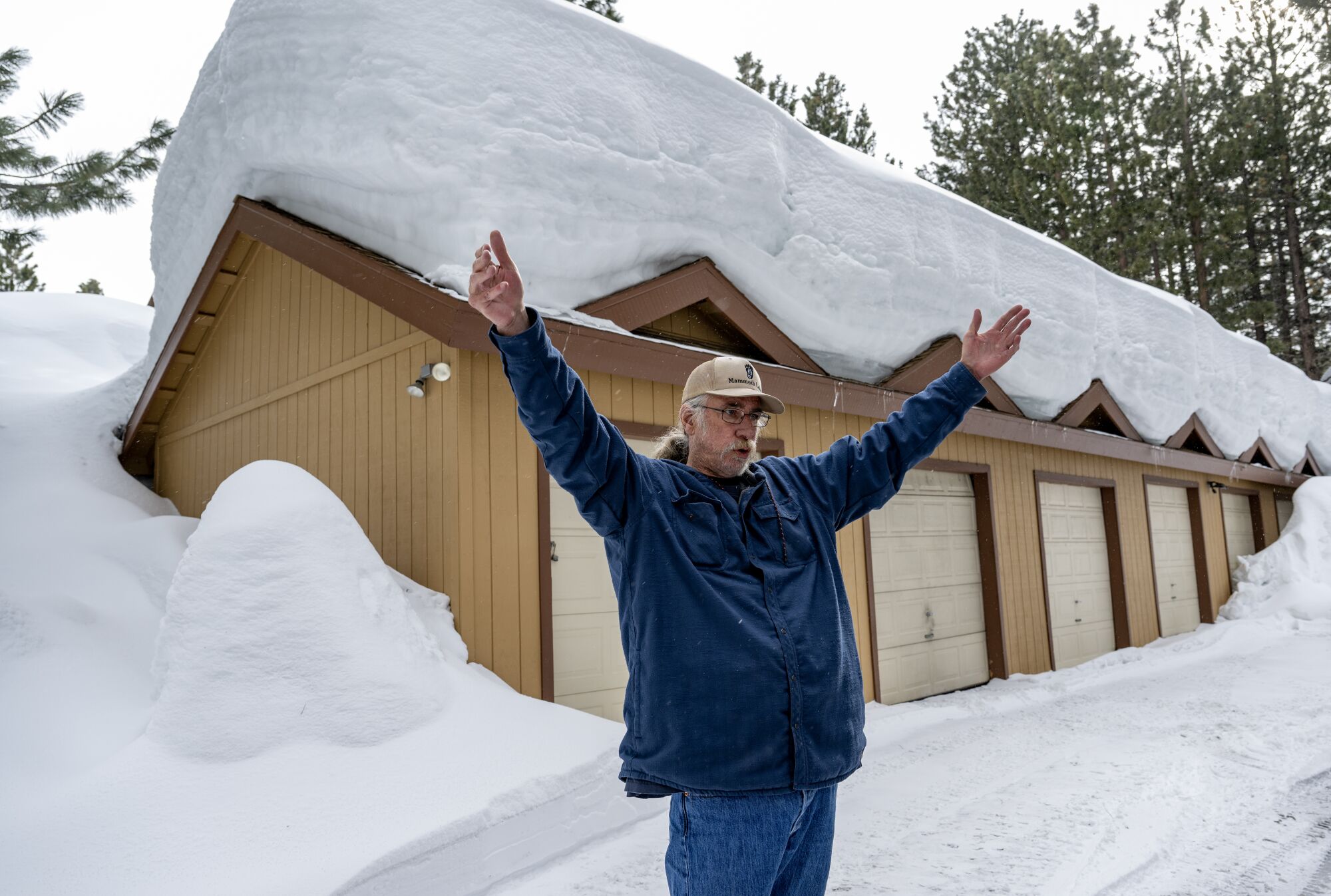
Longtime resident Steve Searles paid more than $11,000 to have crews remove snow from his home in Mammoth Lakes. He is worried about the snow remaining on his garage and the driveway.
(Gina Ferazzi/Los Angeles Times)
Tires squeaked over crystalline snow recently as Steve Searles brought his pickup to an abrupt stop and pointed toward a house and garage half buried in several tons of snow.
“That’s where I live,” said Searles, a local resident who has carved out a career as a “bear whisperer” — someone assigned to protect the ski resort community from the animals. “I recently paid crew members $11,400 for 10 days of service, and it looks like I’m going to have to hire them again.”
Snow removal first became an issue in January as a series of powerful atmospheric rivers began hammering the state. That’s when a snow disposal pit the town had used for years was declared off limits by the U.S. Forest Service. The agency said the town must first complete an environmental impact analysis before continuing to dump snow on the federal property.
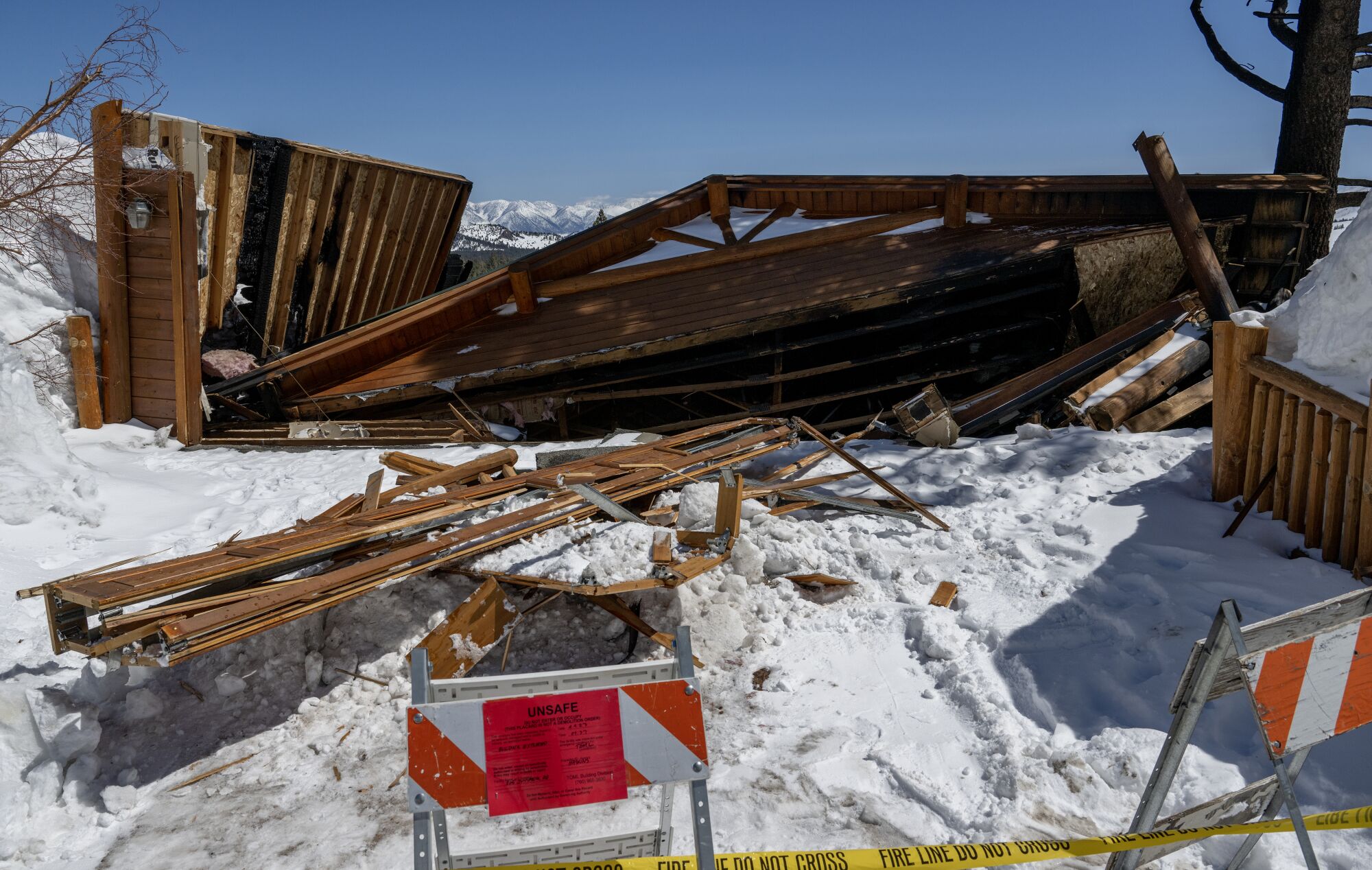
A home on Juniper Road was destroyed when a propane tank exploded in Mammoth Lakes. No one was home at the time.
(Gina Ferazzi/Los Angeles Times)
To deal with rising snow levels, town officials leased property from another landowner, but that site turned into a perpetual traffic jam as a caravan of snow-hauling trucks found themselves idling along a single-lane access road that was too narrow to turn around in.
“In February, we went back to the Forest Service and said, ‘Look, we really need that permit,’” said Stuart Brown, a Mammoth Lakes spokesman. “It was granted.”
The crushing weight of the snow has taken a slow and steady toll on the town’s housing stock.
As of Thursday, 67 buildings in Mammoth Lakes had been red-tagged, meaning the property has been deemed unsafe and entry is limited to authorized personnel. More red tags are expected, officials said, as structures emerge from under melting snowbanks.
Patricia Cervantes, 42, and her 18-year-old son were among 10 low-income families that she said were given 20 minutes to evacuate a two-story “affordable housing” complex after it was red-tagged on March 17 due to structural damage.
The move forced them to frantically search elsewhere for affordable units to rent until qualified structural engineers could assess the damage, a requirement before repair work can begin.
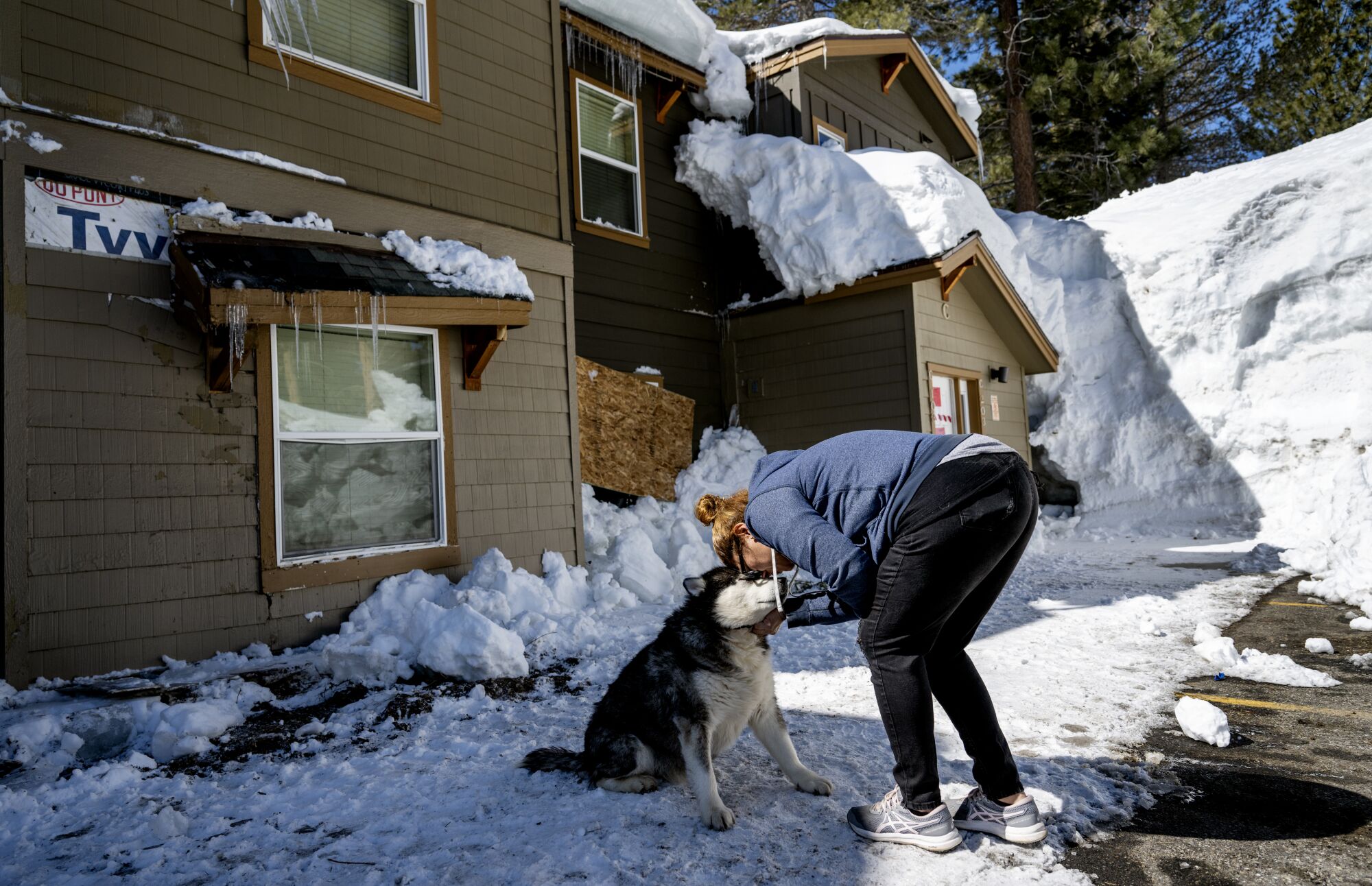
Patricia Cervantes comforts her frightened dog, Stella, after she scampered back into their red-tagged apartment in Mammoth Lakes.
(Gina Ferazzi/Los Angeles Times)
But finding qualified engineers willing to brave the snow and take on a structural damage case involving affordable housing units hasn’t been easy. As one longtime real estate agent put it, “the best structural engineers in town are helping build mansions.”
The damage has only exacerbated tensions in a town where increasing development continues to drive up the cost of rent and real estate.

Workers in Mammoth Lakes are making $60 an hour to clear snow from an apartment building.
(Gina Ferazzi/Los Angeles Times)
“The ski resort and town officials don’t care about us, they only care about making money,” grumbled Cervantes, who runs a house-cleaning business in town. “But we’re the ones who cook their food, make their beds and clean their toilets.”
Cervantes wishes Mammoth Mountain would agree to close its skiing operations for a few days a week. That, she said, “would give us time to take care of personal needs, and to shovel snow off our parking lots.”
Such notions are nothing new in Mammoth Lakes. But so much is riding on snow here — skiing, tourism and the livelihoods of more than 2,000 local workers — that “if we closed down the Mountain we’d be broke,” Holler said.
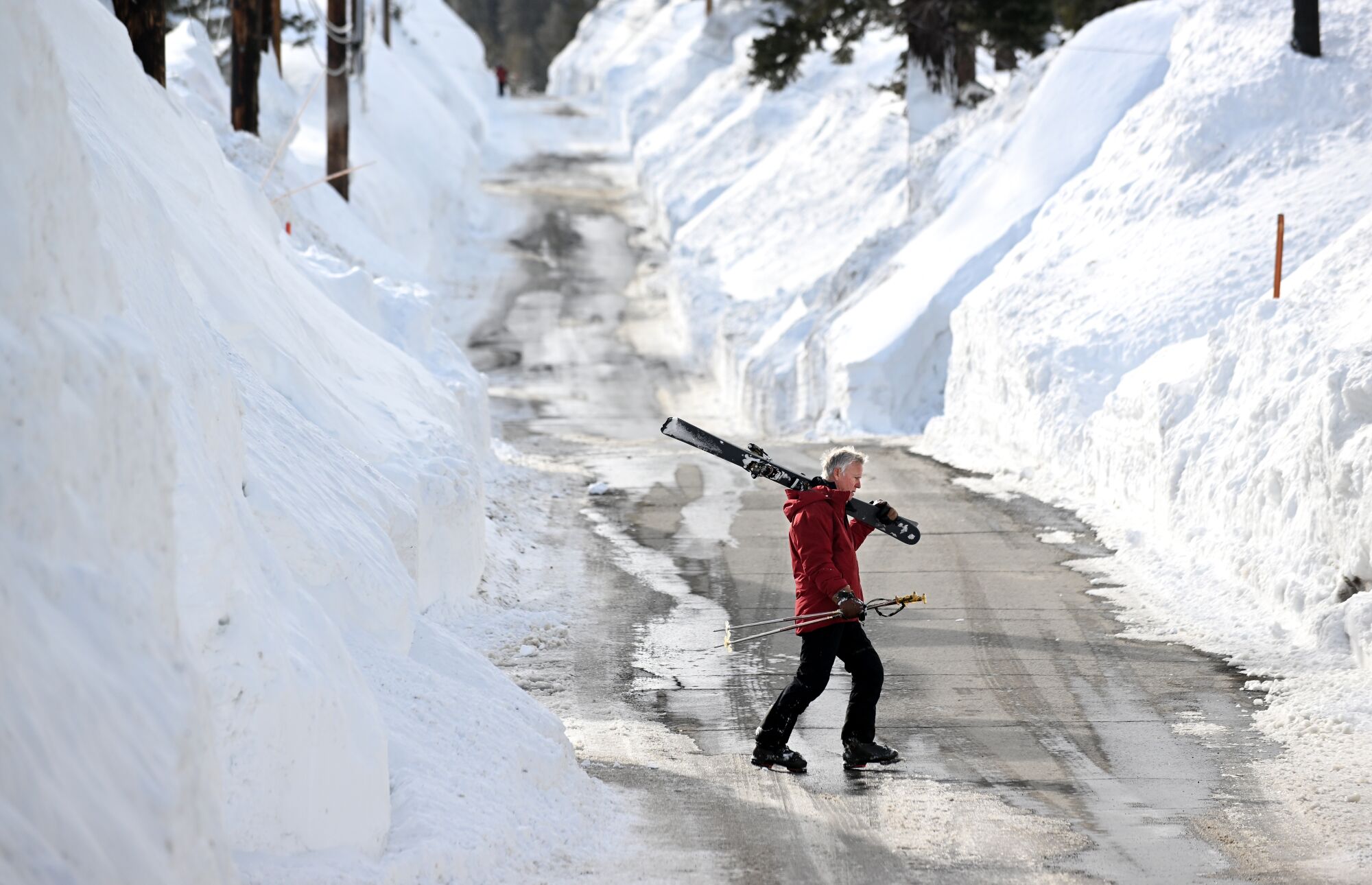
David Frazier crosses Davison Road after a day of skiing at Mammoth Mountain.
(Wally Skalij/Los Angeles Times)
The main draw of this resort town is its 11,053-foot dormant volcano, which offers 3,500 acres of gentle-to-steep terrain for downhill skiers and boarders. The town hosts as many as 35,000 visitors on busy weekends.
A surge in upscale property investment here during the COVID-19 pandemic boosted property taxes and helped secure the economic future of the town with an annual budget of $27 million.
Beyond that, local officials point out that property owners — not the town or state emergency agencies — are responsible for keeping snow loads off their roofs and ensuring that propane gas lines and connections are operating safely.
That hasn’t been easy in an area that recently blew through its all-time record of 668 inches of snow.
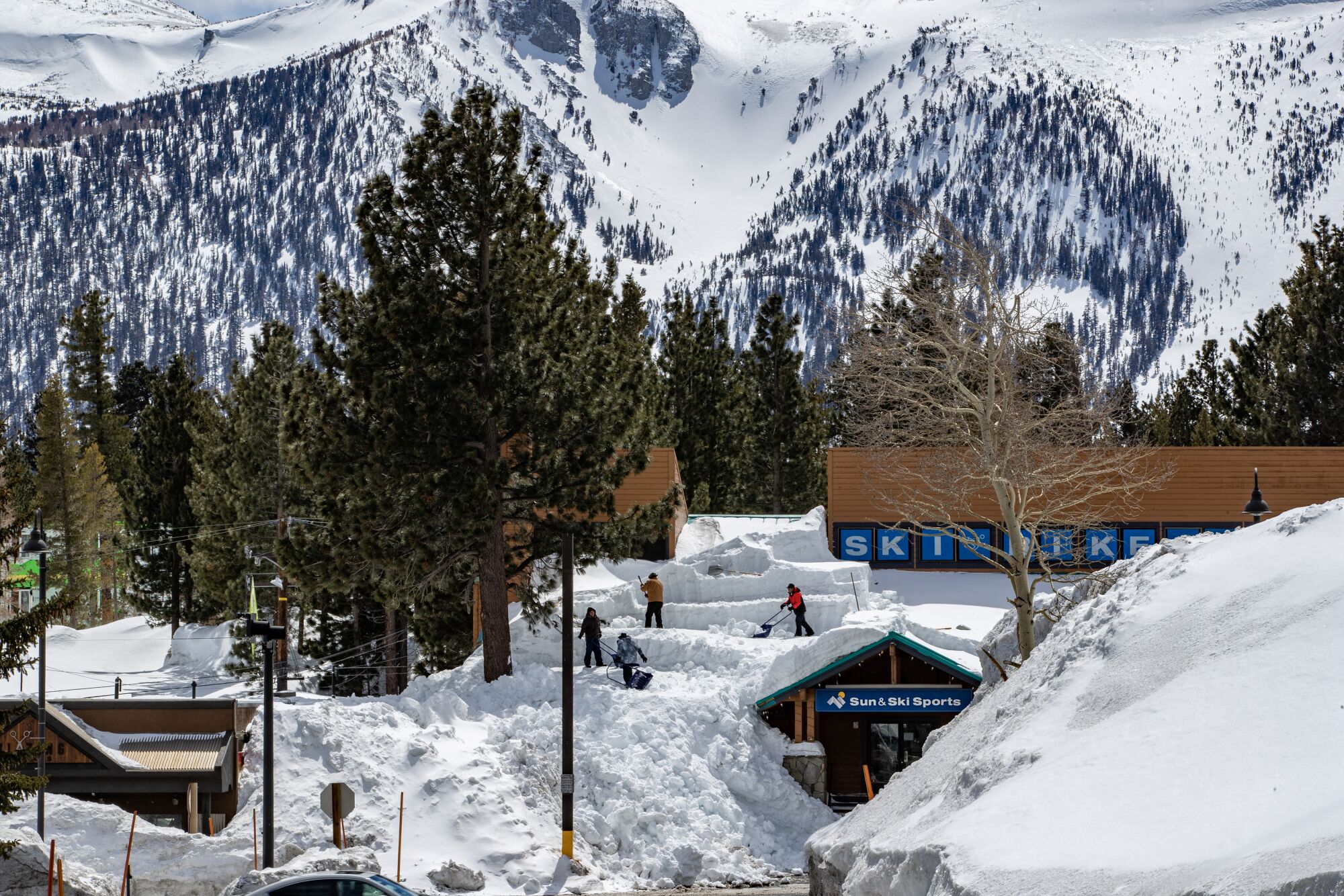
Workers remove mounds of snow on the roof of the Sun & Ski Sports retail shop in Mammoth Lakes.
(Gina Ferazzi/Los Angeles Times)
Now, a growing concern is the prospect of all that snow starting to melt, sending frigid floodwaters racing down white summits and overwhelming local roads and culverts.
Forecasts suggesting that temperatures in Mammoth Lakes could reach 63 degrees on Sunday were met with apprehension in some areas of town.
“We’re ready to deploy 7,500 sandbags as needed,” Brown said. The spokesman also pointed out that the town is receiving ongoing emergency assistance from state agencies including Caltrans, the California Highway Patrol, and the Office of Emergency Services.
But critics are not convinced town officials can be trusted to handle the crisis when the emergency declaration is lifted later this month.
Even town officials say they need help. Holler, for instance, said his requests for “National Guard support in clearing snow on private property and propane connections were rejected.”
“State officials said they were unable to fulfill our requests,” he said, “because National Guard resources were focused on life-threatening flooding in Central California.”
However, in an interview, Brian Ferguson, a spokesman for the Office of Emergency Services, said, “I have no record of the town’s request for National Guard support, which takes time to organize and is used as a last resort.”

A resident clears snow off the roof of his home.
(Gina Ferazzi/Los Angeles Times)
In any case, the town remains on a winter war footing. Last week, the roar of snow blowers spewing geysers of snow into big trucks filled the air.
In neighborhood streets across town, fire department officials were responding to reports of possible propane gas leaks and downed electrical power lines.
Crew members with shovels and clad in snow boots, ear protectors and foul-weather clothing were logging 12-hour days clearing precarious icy ramparts off the roofs of homes and businesses.
They included Jesus Alvarez, 19, and Zelin Sierra, 29, who were using long-handled axes and 10-pound sledge hammers to break apart massive blocks of ice that had fallen off a red-tagged building.
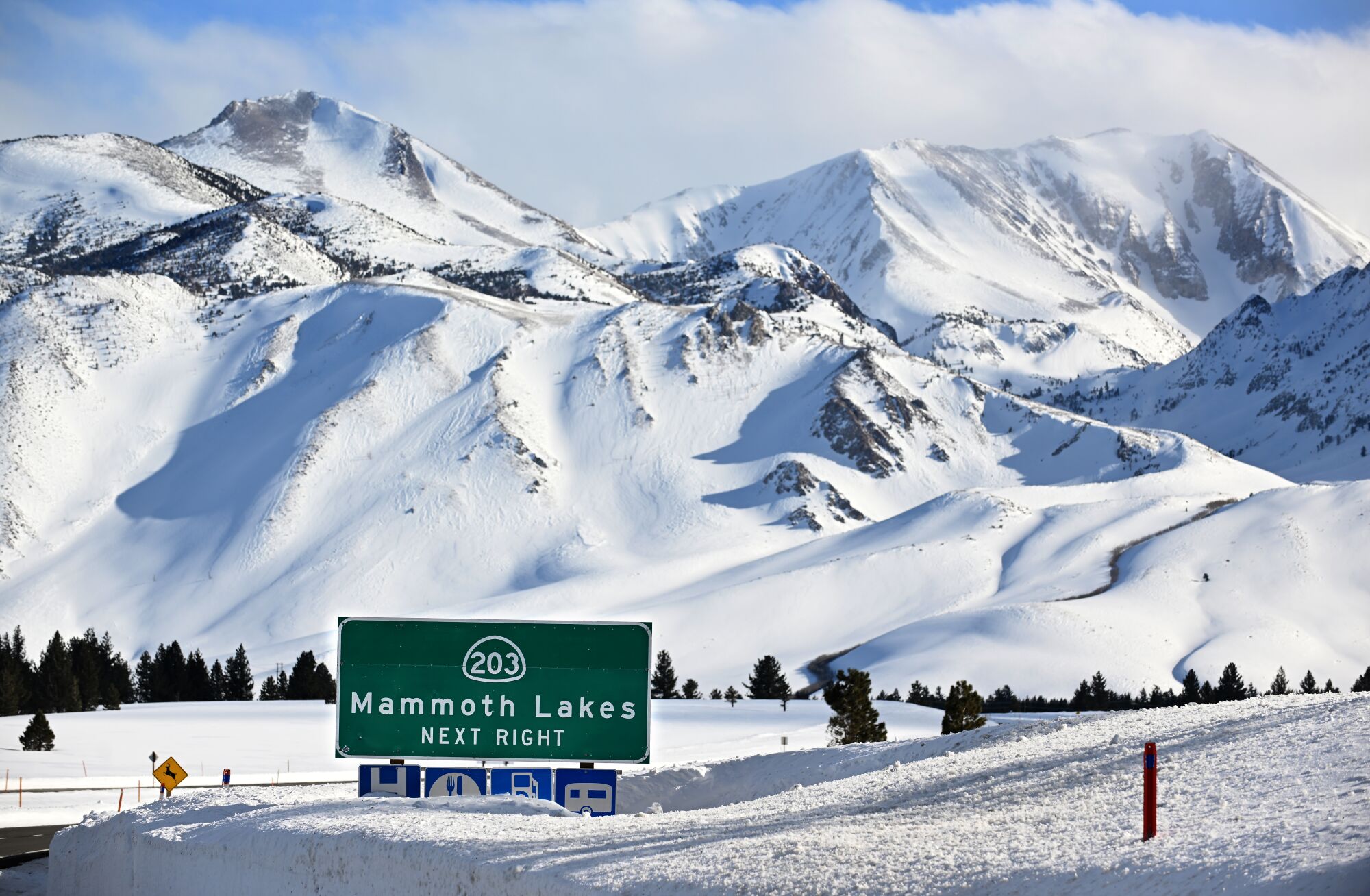
The mountains around Mammoth Lakes are blanketed with snow.
(Wally Skalij/Los Angeles Times)
It was slow, nasty work. But the long hours meant fat paychecks every week, and a chance to make certain dreams come true.
Alvarez was looking forward to a visit with his parents in sunny Mexico.
“It’s been a long time,” he said, breaking into a smile, “and I really want to see them.”
For more latest Education News Click Here

